Explore the rich history of St. Augustine through a captivating walking tour. From the impressive Castillo de San Marcos to the elegant Flagler College campus, this immersive experience immerses visitors in the city’s vibrant past. Marvel at the Spanish colonial architecture lining Aviles Street, and discover the remarkable 16th-century grid system that showcases St. Augustine’s masterful urban design. With a wealth of landmarks and points of interest, this tour promises to transport you back in time and leave you eager to uncover more of the city’s fascinating story.
Key Points

- Explore the Castillo de San Marcos, the oldest masonry fort in the continental U.S., and learn about its strategic importance and military history.
- Visit Flagler College’s historic campus, which was once the lavish Ponce de Leon Hotel, and admire its Spanish Renaissance-style architecture.
- Stroll down Aviles Street, home to some of the oldest structures in the city, and learn about the Spanish colonial architectural style.
- Discover the oldest grid system in the U.S., established in the 16th century, which defines the city’s walkable, pedestrian-friendly atmosphere.
- Gain insights into St. Augustine’s founding by Spanish explorer Pedro Menéndez de Avilés and its evolution as the oldest continuously occupied European settlement in the continental U.S.
St. Augustine’s Founding and Early History

Established in 1565 by Spanish explorer Pedro Menéndez de Avilés, St. Augustine is the oldest continuously occupied European settlement in the continental United States, with a rich history spanning over four and a half centuries.
St. Augustine’s early years were marked by conflicts with neighboring Native American tribes and European powers, as the Spanish sought to establish a permanent foothold in the New World. Despite facing numerous challenges, the city endured, growing into an important strategic military outpost and economic center.
Today, St. Augustine’s well-preserved colonial architecture and historic landmarks offer visitors a unique glimpse into the past, making it a popular destination for those interested in exploring America’s earliest European settlements.
Fascinated by St Augustine's past? More historical tours we've covered
The Oldest Masonry Fort
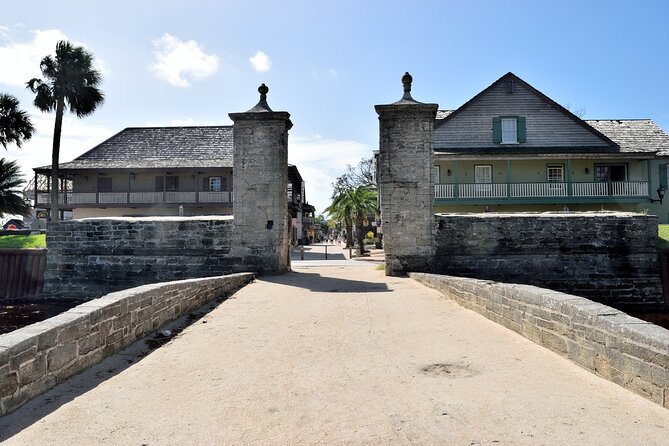
Towering over the city, the Castillo de San Marcos stands as the oldest masonry fort in the continental United States, a testament to Spain’s unwavering determination to defend its New World colonies.
Construction began in 1672 using coquina, a local stone made from compressed seashells, which proved impervious to the cannon fire of the time. The fort served as a critical outpost, withstanding multiple sieges over the centuries.
Today, the Castillo de San Marcos offers visitors a glimpse into the rich military history of St. Augustine, allowing them to:
- Explore the sprawling stone fortifications and imagine the lives of its 17th-century garrison.
- Climb to the top of the battlements for panoramic views of the city and Matanzas Bay.
- Discover the ingenuity behind the Castillo’s design and construction.
Flagler College’s Historic Campus
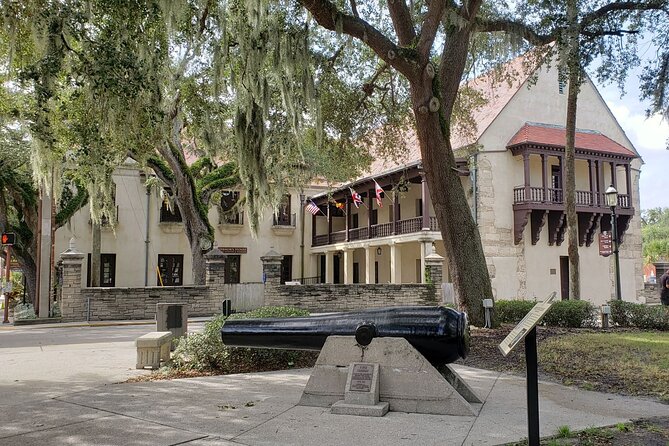
As one explores the historic campus of Flagler College, they’ll find themselves immersed in a captivating blend of architectural grandeur and educational legacy.
The former Ponce de Leon Hotel, built in the late 19th century, now houses the college’s classrooms and facilities, preserving the elegance of its Gilded Age origins. Visitors can admire the intricate Spanish Renaissance-style architecture, featuring ornate carvings, stained-glass windows, and a magnificent rotunda.
The college’s rich history is palpable, with the halls once graced by the presence of industrialist Henry Flagler, whose vision and philanthropy led to the creation of this remarkable institution.
Today, Flagler College stands as a testament to the enduring spirit of St. Augustine, blending its storied past with a vibrant academic present.
Aviles Street and Spanish Colonial Architecture
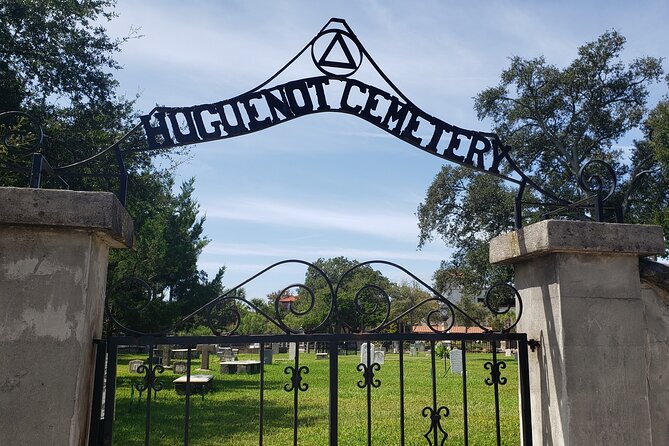
Leaving the grand architecture of Flagler College behind, visitors now find themselves strolling down Aviles Street, where the rich tapestry of St. Augustine’s Spanish colonial heritage unfolds before them.
This quaint, winding street showcases some of the oldest structures in the city, dating back to the 18th and 19th centuries. Visitors can admire:
-
The Aviles Street Historic District, a collection of historic buildings that exemplify the Spanish colonial architectural style, with their stucco walls, red tile roofs, and charming balconies.
-
The colorful and vibrant murals adorning the walls, highlighting the city’s artistic flair and Latin American influences.
-
The local boutiques, art galleries, and cafes, offering a glimpse into the lively cultural tapestry that defines St. Augustine’s Aviles Street.
The Oldest Grid System in the U.S
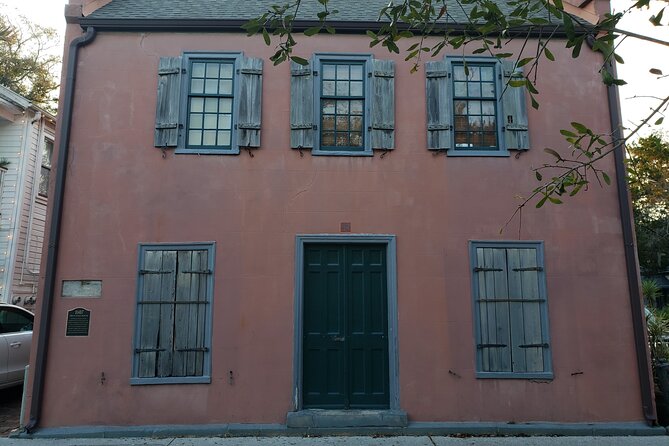
St. Augustine boasts the oldest grid system in the United States, a testament to the city’s enduring Spanish colonial heritage. Established in the 16th century, this meticulously planned layout of streets and blocks has long served as the foundation for the historic city’s development, guiding its growth and shaping its unique character over the centuries.
The grid system’s impact is evident in the following key facts:
| Fact | Statistic |
|---|---|
| Number of streets in the original grid | 29 |
| Percentage of streets that remain part of the original grid | 80% |
| Average block size | 330 ft x 120 ft |
This masterful urban design not only showcases St. Augustine’s storied past but also continues to define the city’s walkable, pedestrian-friendly atmosphere today.
If you're enjoying exploring St Augustine on foot, you'll love these other walking tours we recommend
Key Landmarks and Points of Interest
Visitors exploring the historic walking tour of St. Augustine will discover an array of captivating landmarks and points of interest that showcase the city’s rich heritage.
The iconic Castillo de San Marcos, the oldest masonry fort in the continental United States, stands as a testament to the city’s Spanish colonial past.
Nearby, the oldest surviving grid system in the U.S. offers a glimpse into the urban planning of early St. Augustine.
Plus, the magnificent Flagler College, once the luxurious Hotel Ponce de Leon, exemplifies the Gilded Age opulence that transformed the city in the late 19th century.
These and other historic sites provide a comprehensive introduction to St. Augustine’s storied past.
Tour Duration and Logistics
The historic walking tour of St. Augustine runs for approximately 100 minutes, providing visitors with a rundown of the city’s storied past.
Operated by St. Augustine Experiences, the tour departs from the meeting point at The Bart Art Gallery on Aviles Street and concludes at the Plaza de la Constitucion on St George Street.
With a maximum group size of 10 travelers, the tour ensures a personalized experience as participants explore the city’s top landmarks, including the oldest masonry fort, oldest grid system, and Flagler College.
The tour is wheelchair and stroller accessible, and service animals are welcome.
Confirmation is provided at the time of booking, and free cancellation is available up to 24 hours before the experience.
Tour Inclusions and Accessibility
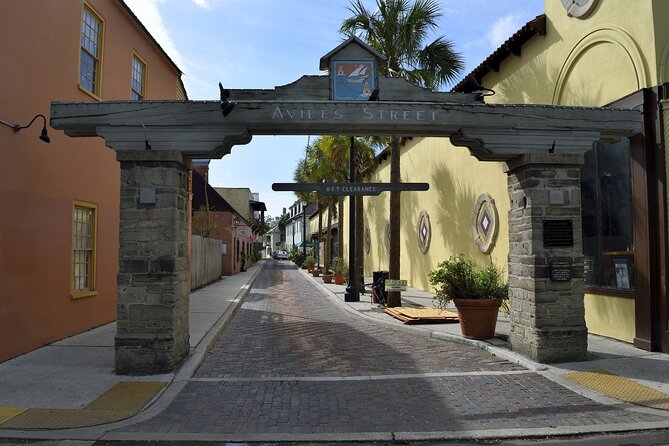
The historic walking tour includes all fees and taxes, and participants can conveniently meet and be picked up at The Bart Art Gallery on Aviles Street. The tour is accessible to wheelchair users and those with strollers, and service animals are allowed. Plus, the small group size ensures a personalized experience for all travelers.
The tour covers St. Augustine’s 450-year history, providing a rundown of the oldest city in the United States.
Participants will visit top landmarks, including the oldest masonry fort, oldest grid system, and Flagler College.
The tour is operated by St. Augustine Experiences and offers free cancellation up to 24 hours before the experience.
Frequently Asked Questions
Can I Bring My Own Water on the Tour?
Yes, guests are welcome to bring their own water on the tour. The tour is outdoors and can last up to 100 minutes, so staying hydrated is recommended. Water bottles are allowed and can be brought along during the walking tour.
Is There a Discounted Rate for Seniors?
Yes, the tour operator offers a discounted rate for seniors. Seniors can save on the tour price by presenting a valid ID at the meeting point. The discount is available for those aged 65 and above.
How Long Is the Walking Distance of the Tour?
The walking distance of the tour is approximately 1 mile. The tour takes around 100 minutes to complete, providing a rundown of St. Augustine’s historic landmarks and 450-year history within a small group setting.
Do I Need to Bring My Own Headphones?
No, headphones aren’t necessary for this tour. The guide will provide an engaging, informative overview of the historic landmarks using their own voice, so you can fully learn about the experience without the need for additional audio equipment.
Is Photography Allowed During the Tour?
Yes, photography is allowed during the tour. Participants are encouraged to capture the historic landmarks and scenery along the walking route to commemorate their experience in the oldest city in the United States.
Recap
The history walking tour in St. Augustine offers a captivating exploration of the city’s rich past.
From the iconic Castillo de San Marcos to the elegant Flagler College campus, the tour immerses visitors in the city’s architectural and cultural heritage.
Highlights include the Spanish colonial influences on Aviles Street and the remarkable 16th-century grid system, providing a comprehensive understanding of St. Augustine’s remarkable history and urban design.
More Walking Tours in St Augustine
- Private Guided Walking History Tour Review
- St. Augustine City Self-Guided Walking Audio Tour Review
- America’s Oldest City: A Self-Guided Walking Tour of St Augustine
- Booze and Boos Haunted St. Augustine Ghost Walking Tour
- Walking and Tasting Tour of Historic St. Augustine
- Secrets of Saint Augustine Historical Walking Tour
More Tours in St Augustine
More Tour Reviews in St Augustine
Not for you? Here's more things to do in St Augustine we have recnetly reviewed
- 19 Best Cruises And Boat Tours In St Augustine
- 2 Best Food Tours In St Augustine
- The Last Stop Private Paranormal Investigation up to 5 People!
- Sand Surfing and Guided Beach Ride in Florida
- Transportation Services, St. Augustine
- Fun Interactive Digital Scavenger Hunt in St. Augustine
- Private Black Car and Limousine Service With Chauffeur for 2 Hours
- Private Professional Holiday Photoshoot in St Augustine
- 1 Hour Private Historical Tour of Saint Augustine, Florida
- Dolphin Watch & Historical Harbor Tour in St. Augustine
- Dolphin, Manatee and Sea Turtle Kayak Adventure
- The Beer Bus- Craft Beer in St. Augustine
